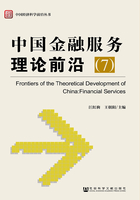
参考文献
[1] Allen, Mark, Rosenberg Christoph, Keller Christian, Setser Brad, and Roubini Nouriel,“A Balance Sheet Approach to Financial Crisis”, IMF Working Paper, No.02/210,2002.
[2] Barry Naughton, “Is China Socialist? ”, Journal of Economic Perspectives. Vol.31, No.1. Winter. 2017.
[3] Chang, Roberto and Velasco, Andres, “Liquidity Crises in Emerging Markets: Theory an Policy”, NBER Working Paper, No. 7272,1999.
[4] Cole, Harold and Kehoe, Patrick, “A Self-Fulfilling Model of Mexico's 1994-1995 Debt Crisis”, Journal of International Economics, Vol. 41, November, pp.309-330, 1996.
[5] Diamond, Douglas and Dybvig, Philip, “Bank Run, Deposit Insurance, and Liquidity”, Journal of Political Economy, Vol.91, pp.401-419,1983.
[6] Dickinson, Frank, and Eakin, Franzy, A Balance Sheet of the Nation's Economy. University of Illinois. 1936.
[7] Flood, Robert and Garber, Peter, “Collapsing Exchange Rate Regimes: Some Linear Examples”, Journal of International Economics, Vol.17, pp.1-13,1984.
[8] Frecaut, Olivier, “A National Wealth Approach to Banking Crises and Financial Stability”, IMF Working Paper, No.16/128,2016.
[9] Frecaut, Olivier, “Indonesia's Banking Crisis: A New Perspective on $50 Billion of Losses”, Bulletin of Indonesian Economic Studies, Vol. 40, No.1,2004.
[10] Frecaut, Olivier, “Systemic Banking Crises: Completing the Enhanced Policy Respon-
ses”, Working Paper,2017.
[11] Goldsmith, R., W., and Lipsey, R. E., Studies in the National Balance Sheet of the United States, Princeton University Press. 1963.
[12] Goldsmith, Raymond W., The National Balance Sheet of the United States,1953-1980, The University of Chicago Press. 1982.
[13] Holder, Andrew., Developing the Public-sector Balance Sheet, Economic Trends, No. 540, pp.31-40. 1998.
[14] IMF Statistics Department, “The System of Macroeconomics Accounts Statistics—An Overview”, Pamphlet Series No.56,2007.
[15] Krugman, Paul, “A Model of Balance of Payments Crises”, Journal of Money, Credit and Banking, Vol.11, pp.311-325,1979.
[16] Laeven, Luc and Valencia, Fabian, “Systemic Banking Crisis Database”, IMF Economic Review, Vol.61, No.2,2013.
[17] Li, Yang and Zhang, Xiaojing,2013, “China's Sovereign Balance Sheet and Implications for Financial Stability”, in China's Road to Greater Financial Stability: Some Policy Perspectives (editor: Udaibir S Das, Jonathan Fiechter and Tao Sun), IMF Press,2013.
[18] Mathisen, Johan, and Pellechio, Anthony, Using the Balance Sheet Approach in Surveillance: Framework, Data Sources, and Data Availability, IMF Working Paper, WP/06/100,2006.
[19] Piketty, Thomas, Li Yang and Gabriel Zucman,2017, “Capital Accumulation, Private Property and Rising Inequality In China,1978-2015”, NBER Working Paper 23368.
[20] Sheng, Andrew and Ng, Chow Soon, “Shadow Banking in China: An Opportunity for Financial Reform”, John Wiley &Sons Ltd., UK,2016.
[21] Sheng, Andrew,2016, Shadow Banking in China: An Opportunity for Financial Reform, Wiley;1 edition.
[22] Winkler, Bernhard, van Riet Ad, and Bull Peter, “A Flow- of- Funds Perspective on the Financial Crisis”, Palgrave Macmillan, UK,2013.
[23] 伯南克:《行动的勇气:金融危机及其余波回忆录》,蒋宗强译,中信出版集团,2010。
[24] 曹远征、马骏:《问计国家资产负债表》,《财经》2012年6月11日。
[25] 杜金富等编著《政府资产负债表:基本原理及中国应用》,中国金融出版社,2015。
[26] 辜朝明:《大衰退》,东方出版社,2009。
[27] 李扬:《要从资产负债表来控制资产泡沫》, 2009年夏季达沃斯论坛发言,见http://money.163.com/09/0910/15/5IS2VHQJ00253NDC.html。
[28] 李扬、张晓晶、常欣等:《中国国家资产负债表2013——理论、方法与风险评估》,中国社会科学出版社,2013。
[29] 李扬、张晓晶、常欣等:《中国国家资产负债表2015——杠杆调整与风险管理》,中国社会科学出版社,2015。
[30] 联合国、欧盟委员会、经济合作与发展组织、国际货币及基金组织、世界银行:《2008年国民账户体系》,中国统计出版社,2012。
[31] 庞巴维克:《资本实证论》,商务印书馆,1997。
[32] 易纲:《中国能够经受住金融危机的考验》,《求是》2008年第22期。
[33] 银监会:《中国银行业监督管理委员会2012年报》, 2012。
[34] 余斌:《国家(政府)资产负债表问题研究》,中国发展出版社,2015。
[35] 张晓慧:《宏观审慎政策在中国的探索》,《中国金融》2017年第11期。